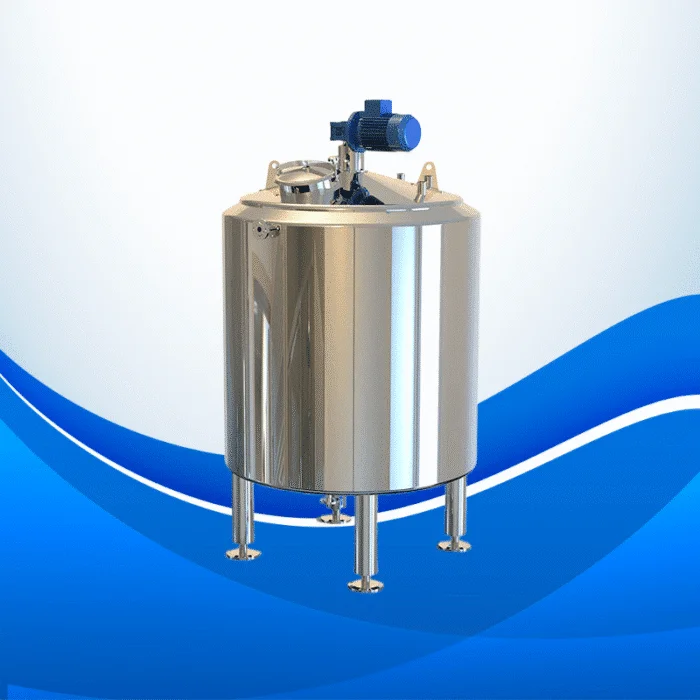In industrial production, efficiency is crucial, particularly when handling processes that involve heat-sensitive substances. Whether it’s the food, pharmaceutical, or chemical industry, effective heat management is vital for product consistency and quality. This is where Jacket Mixing Tank come into play. These specialized tanks are designed to enhance heat transfer efficiency, which leads to faster production times, improved product quality, and reduced energy costs. In this article, we will explore how Jacket Mixing Tanks enhance heat transfer efficiency, their benefits, and their applications in various industrial settings.
What Is a Jacket Mixing Tank?
A Jacket Mixing Tank is a mixing vessel that incorporates a jacketed design for temperature control. The tank features an outer wall, or “jacket,” through which a heating or cooling medium circulates. This medium can be water, steam, or oil, depending on the process’s temperature requirements. The heated or cooled medium inside the jacket helps regulate the temperature of the contents in the tank, ensuring that the materials are mixed and heated to the desired consistency.
The Jacket Mixing Tank is commonly used in industries where maintaining a consistent temperature during mixing is crucial. Its design allows for precise temperature control, preventing overheating or underheating, which can affect the quality of the final product.
The Role of Heat Transfer in Jacket Mixing Tanks
Heat transfer is a fundamental concept in many industrial processes. It involves the movement of heat from a hotter substance to a cooler one until equilibrium is achieved. In the case of a Jacket Mixing Tank, the jacketed design ensures that heat is efficiently transferred to or from the materials inside the tank.
The tank’s jacket allows for an even distribution of heat, preventing hot spots or uneven temperatures within the mixture. This uniform heat distribution is essential for ensuring that the materials are mixed properly and at the correct temperature. Without efficient heat transfer, the mixing process may lead to inconsistent product quality, reduced shelf life, or even spoilage in the case of food or pharmaceutical products.
How Jacket Mixing Tanks Improve Heat Transfer Efficiency
Jacket Mixing Tanks are specifically designed to enhance the efficiency of heat transfer during mixing processes. Here’s how they achieve this:
Consistent Heat Distribution
One of the primary benefits of a Jacket Mixing Tank is the even distribution of heat. Unlike traditional mixing tanks, which may have uneven heating, the jacketed design ensures that heat is applied uniformly around the tank. This uniformity prevents temperature fluctuations within the mixture, leading to more consistent results.
The even heat distribution also reduces the need for additional heating elements or external equipment. By optimizing the heat transfer process within the tank itself, these tanks can operate more efficiently and require less energy.
Enhanced Mixing Efficiency
The efficiency of the mixing process is closely tied to the tank’s heat transfer capabilities. In a Jacket Mixing Tank, the heat provided by the jacket aids in the smooth mixing of materials, particularly for substances that are sensitive to temperature changes. For instance, when mixing thick liquids or pastes, maintaining the right temperature ensures that the mixture flows smoothly without becoming too dense or clumpy.
With improved heat transfer efficiency, the Jacket Mixing Tank ensures that ingredients are blended at the ideal temperature, resulting in a uniform mixture. This not only enhances the quality of the final product but also accelerates the mixing process, thereby reducing production time and increasing throughput.
Reduction in Temperature Variability
Temperature control is crucial in many industries, particularly when handling heat-sensitive materials. Jacket Mixing Tanks help minimise temperature fluctuations, which can otherwise result in inconsistent product quality. By maintaining a stable and controlled temperature, these tanks ensure that the mixing process is efficient and precise. This is especially important in industries such as food processing, where temperature variations can significantly impact the taste, texture, and overall quality of the product.
The jacketed design of the tank creates a buffer zone between the heating or cooling medium and the contents inside the tank. This prevents sudden temperature spikes or drops, allowing for more gradual and controlled changes in temperature.
Energy Efficiency of Jacket Mixing Tanks
Energy efficiency is a crucial factor in industrial operations, particularly as energy costs continue to increase. Jacket Mixing Tanks are designed to improve heat transfer efficiency, which directly translates to reduced energy consumption.
By providing precise temperature control, the jacketed design ensures that the heating or cooling process requires less energy. The tank’s jacket allows for direct contact with the mixture, eliminating the need for additional heating elements or complex external systems. This results in lower energy usage, which can significantly reduce operational costs over time.
Furthermore, the energy efficiency of Jacket Mixing Tanks contributes to a more sustainable production process. By minimising energy consumption and waste, these tanks help industries reduce their carbon footprint while maintaining optimal performance.
Applications of Jacket Mixing Tanks in Different Industries
Jacketed mixing tanks are used across various industries, each benefiting from improved heat transfer efficiency. Here are some typical applications:
Food and Beverage Industry
In the food industry, heat control is essential for achieving the desired texture, flavour, and consistency of products. Jacketed mixing tanks are used to mix and heat substances such as sauces, soups, syrups, and chocolates. The precise temperature control ensures that these products are heated to the correct temperature without compromising their quality.
For example, when making chocolate, it’s crucial to maintain a specific temperature to achieve the smooth texture and consistency desired. Jacketed mixing tanks help maintain this temperature, ensuring that the chocolate mixture does not overheat and become unusable.
Pharmaceutical Industry
In pharmaceutical manufacturing, the consistency and safety of the product are of utmost importance. Jacket Mixing Tanks are used to blend and heat ingredients for various medicines, ensuring that the active ingredients are mixed properly and at the correct temperature. This helps preserve the integrity of the ingredients and provides the efficacy of the final product.
Chemical Industry
The chemical industry often deals with mixtures that require precise temperature control to maintain chemical properties. Jacket Mixing Tanks help prevent overheating, which could cause unwanted chemical reactions or degradation of the materials. By maintaining a consistent temperature, these tanks enhance the efficiency of the mixing process and ensure the safety and stability of the final product.
Conclusion
The Jacket Mixing Tank is a valuable tool for industries that require precise temperature control during mixing. By enhancing heat transfer efficiency, these tanks improve product quality, reduce energy consumption, and streamline production processes. Whether you are in the food, pharmaceutical, or chemical industry, investing in a Jacket Mixing Tank can lead to significant improvements in both efficiency and product consistency.
Maintaining a stable, controlled temperature during mixing is crucial for ensuring that heat-sensitive materials are correctly processed. With their ability to provide even heat distribution and reduce temperature variability, Jacket Mixing Tanks are a critical component in modern industrial operations.



